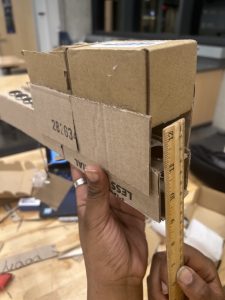Risks:
The main risk with our project is that we aren’t able to get our Arduino integrated duty cycle for the voltage to vary the current in the speed coils. This would mainly affect the propulsion system. In the case we can’t get the magnetic propulsion system functional we would pivot to a mechanical wheel system and have some type of battery or motor for the carrier. Achieving levitation and stability with levitation as well is a risk. To mitigate this risk we have designed our carrier with elongated sides to slightly contact the track to make sure it does not fall off.
Design Changes:
- Lidar to Ultrasonic Sensor with Blockage system
- Digital Potentiometer to H-Bridge with speed up coil
- Straight-Away track for MVP
Schedule Changes:
- Push back when we design speed up coils
- Push back prototype 2
- Since we are no longer using the lidar sensor, we have freed parts of our schedule. Therefore, we have time to push back parts of our schedule
A was written by Angel Nyaga, B was written by Emanuel Abiye and C was written by Myles Mwathe.
Part A:
Given that our product involves a user interface, there is good reason to consider what safety mechanisms the product has. This product is intended to have the user have as little interaction with the circuit as possible. To get the train to move, a button, separate from the main circuit is pressed. This little interaction protects the user from the possibility of being hurt by components of the circuit.
Additionally, magnetic fields are often associated with negative health effects. This is only true when someone is in contact with a high amounts of magnetic fields. Since our system is small, a small amount of current is required to power the system. This means a small magnetic field is produced, meaning the user is not in danger.
Lastly, we want to advise people with magnetic or conducting materials to steer clear of the product. Given that our system is dependent on magnetism, there is a high possibility a conducting or magnetic component can interfere with the system without our control. This interference could result in damage to the product and harm to anyone near the product. For this reason, we would put up a visual disclaimer to anyone approaching the product with conducting and magnetic material.
Part B:
Our project aims to target train enthusiasts and those interested in Maglev Trains and would like to learn more about them. Our product offers an interactive learning experience for both kinds of users. For enthusiasts, we wanted to make sure that our product mirrored real life Maglev Trains and their functionality, with such components being the levitation and wanted to ensure authenticity to our product that can stand out to similar products. With the overall quality gap we plan on having compared to current MagLev model train sets, we believe that we can successfully cater to such users. And with such a gap mentioned before, train enthusiasts would be fine with our proposed cost for our product. For those that primarily would want to learn more about MagLev Trains, we are allowing our product to take in user input, allowing users to experiment with how MagLev trains would respond to such inputs. With examples such as affecting the speed, or having a carrier move from one stop to the next, or manipulating the current throughout the track, we want these users to learn how the MagLev carriers react to these changes, and have these reactions be as accurate as possible to an actual MagLev train. Again, with how wide we expect the gap to be compared to current MagLev model train sets, we believe that the cost accurately represents the wide variety of experiments and knowledge the user can learn from our product, and would be fine with the proposed cost. Overall, we are hoping to have a mutual appreciation of MagLev trains from both kinds of users, and possibly allow train enthusiasts to become the kind of user that would want to learn more about MagLev trains, and allow those that want to learn more about MagLev trains become train enthusiasts themselves.
Part C:
We are mindful of the current model maglev trains on the market and their prices currently. The most functional maglev train set that allows for propulsion goes for around $450. Some simpler models cost less but don’t have propulsion systems beyond the user pushing the train along the track manually. Some maglev model trains require materials like liquid nitrogen which may be expensive and hard to obtain for the average user of our product.
Given that our budget for the project as a whole is $600 and that most of the components of our MVP are relatively inexpensive, staying below a price of $450 should be relatively easy. Since we are pivoting our design to use ultrasonic sensors and magnetometers instead of a LiDAR system, we not only simplify the complexity of implementation but the overall cost of our project as well. The magnets we would be using for the product are also relatively inexpensive given that the load of our carrier won’t be heavy enough to justify having to use stronger, more costly magnets. We aim to make our product accessible to people who want to learn about electromagnetics and the average train hobbyist so we don’t want there to the price point of the product to be an accessibility limiter for users. When our process becomes optimized for production we should be able to cut the costs of the product even further since we wouldn’t be doing prototyping and experimentation.


